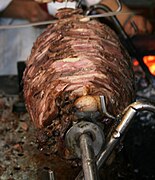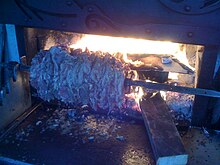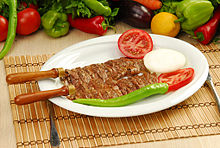Cağ kebabı
 The horizontally stacked meat on the rotating spit is being turned to be served. Note the wood fire behind the system, which is used to cook the meat. | |
| Alternative names | Tortum kebabı , Oltu kebabı |
|---|---|
| Course | Kebab |
| Place of origin | Turkey |
| Region or state | Erzurum |
| Created by | Disputed, with various lawsuits. Goes back to 18th century.[1] |
| Main ingredients | Marinated slices of lamb, tail fat, onion, sweet basil, black pepper and salt. |
Cağ kebabı (pronounced [ˈdʒaː cebabɯ]) is a rotating kebab variety, originating in Turkey's Erzurum Province. The cities of Tortum and Oltu in the said province and Yusufeli in the neighboring Artvin province are in a heated debate concerning the origin of the dish. As such, in Turkish metropolises, this dish can be called "Oltu kebabı" or "Tortum kebabı" depending on the origins of the chef.
This uniquely prepared kebab has become, as years passed, a trademark of Erzurum where all the famous Usta[2] like Şakir Aktaş and Kemâl Koç run restaurants each claiming to be descending from the exclusive inventors.
Note that while it is increasingly available in most Turkish cities, the Cağ kebabı is especially popular in Bursa, whereas enjoying an ever-growing success in Istanbul and Ankara.
History
Ottoman Travelbooks of the eighteenth century cite a kebab cooked on wood fire consisting of horizontal stack of meat, known as "Cağ Kebabı" in the Eastern Turkish province of Erzurum, which is probably the ancestor of the Döner as we know it.[3][4]
Etymology
The word "Cağ" IPA: [ˈdʒaː] in the Eastern Turkish dialects, literally means "spit". Hence the name of the kebab that consists of meat impaled on a huge spit.
Preparation
Slices of lamb and large quantities of tail fat are left to marinate in a mixture comprising a lot of yoğurt, black pepper and sliced onions for the length of a day. They are then impaled on the spit (Cağ), and stacked heavily. The spit is then locked and transferred to the fire where there is a fairly complicated device that controls the cooking of the spit. This typically includes a mechanism for turning the meat, another one for raising and lowering it, and also dents on the side to move the stack towards the fire as it gets thinner after being served repeatedly.
Note that the meat used for Cağ kebabı is exclusively lamb.[5]
-
Stacking the lamb slices on the Cağ
-
Cağ kebabı being cut
-
Newly impaled meat cooking on the Cağ
-
Cağ kebabı served.
See also
References & Footnotes
- ^ Yierasimos, Marianna (Γιεράσιμος, Μαριάννα) (2005). 500 Yıllık Osmanlı Mutfağı (500 Years of Ottoman Cuisine) (in Turkish). Istanbul: Boyut Kitapları Yayın Grubu. p. 307. ISBN 975-23-0111-8.
{{cite book}}: CS1 maint: multiple names: authors list (link) - ^ "Usta" is a Turkish word, similar in its sense to the French word "maître" although its scope of use is wider, and it is a title, usually added after the first name, to denote a master of any craft or trade.
- ^ "Döner Hakkında – Dönerin Tarihçesi" (in Turkish). Dönercibaşı- Özbilir Grup. Retrieved 2009-03-03. [dead link]
- ^ İskenderoğlu, Yavuz (2008). "Yavuz İskenderoğlu-Kebapçı İskender Tarihçesi" (in Turkish). Kebapçı İskender. Retrieved 2009-03-03.
- ^ Yaman, Renan (1993). Döner Kebabın Hikâyesi (Story of the Döner Kebab) (in Turkish). Ankara: THKATV Yayınları. pp. 92–102.
External links
- http://www.gelgorcagkebabi.com/ - the restaurant of Şakir Aktaş in Oltu, Erzurum, claiming the invention
- http://www.cagkebap.com/cagkebap.htm - the restaurant of Kemâl Koç from Tortum, Erzurum, claiming the invention




